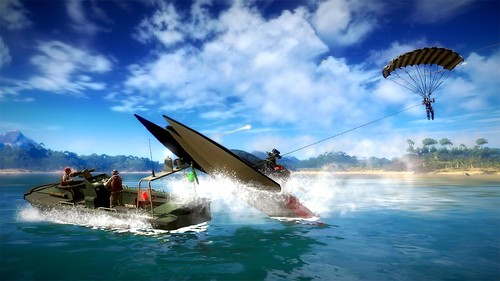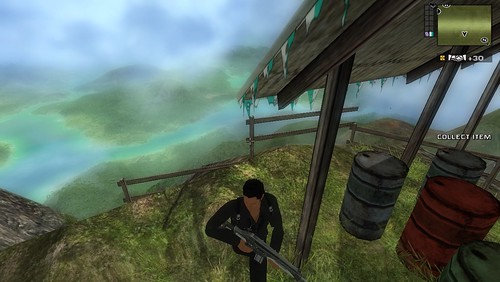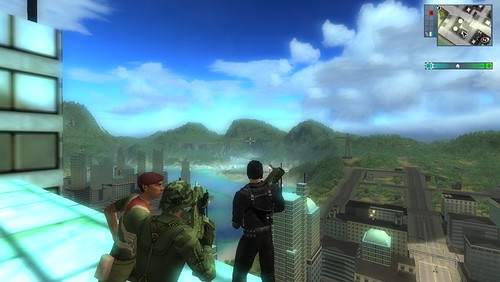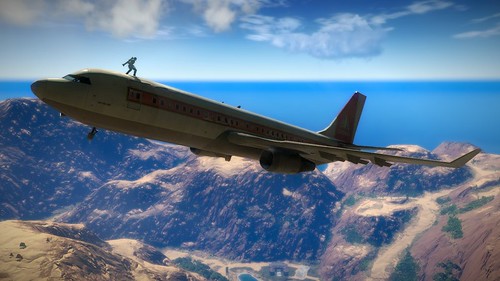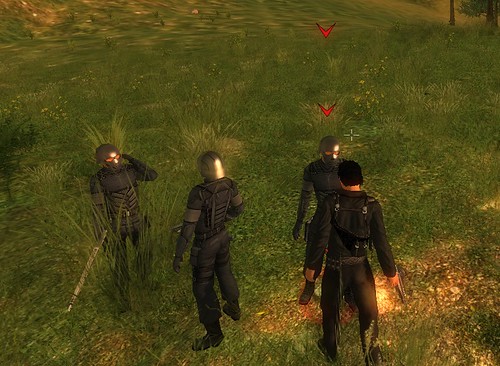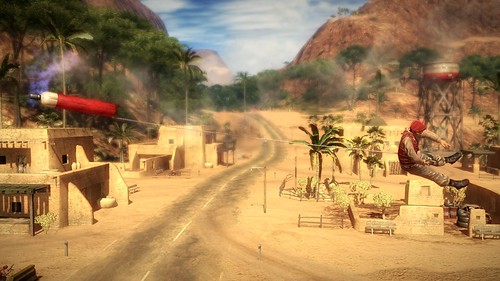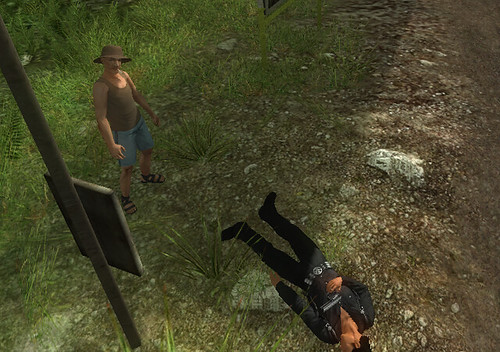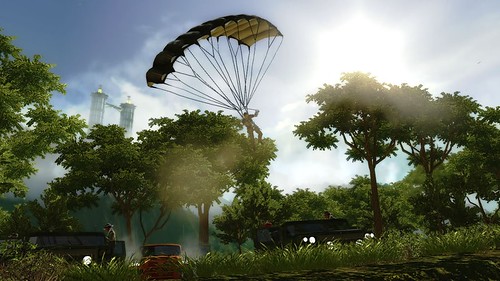TOM FRANCIS
REGRETS THIS ALREADY
Hello! I'm Tom. I'm a game designer, writer, and programmer on Gunpoint, Heat Signature, and Tactical Breach Wizards. Here's some more info on all the games I've worked on, here are the videos I make on YouTube, and here are two short stories I wrote for the Machine of Death collections.
Theme
By me. Uses Adaptive Images by Matt Wilcox.
Search
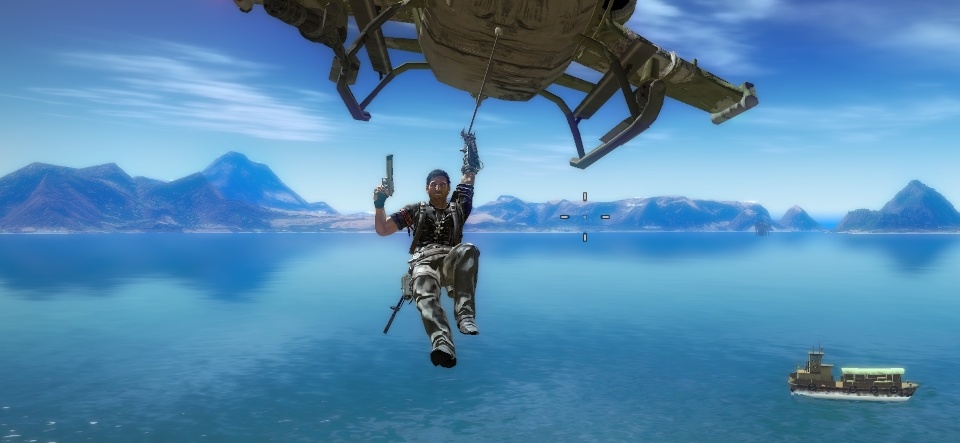
An Idea For A Better Open World Game
The last post was figuring out what we all like in open world games; this one’s about how to make that stuff work together. Can you include it all in one game, and still avoid theme-park silliness and repetitive grinding? No, probably not, but the ideas that crop up when you try are interesting.
I had to pick a specific open world to talk about to prevent this from becoming hopelessly vague, so these are all ideas for how a game like Just Cause 2 could work. I chose that not because of any qualms with it, but because the first one was a classic example of a wonderful open world, gorgeous and fun to move around in, without much going on in it. The sequel’s even more inviting and even more fun to traverse, so it’s a great chassis to plug some cool ideas into.
This got long, so first I’ll summarise:
Give the player the option to set up camp in their favourite place, upgrade it with the features they want, and liberate other areas they like through a simple but high-level strategy game played out on the world map.
Split the main story into separate series of missions with a common theme – Sabotage, Assassination and Heroics. They have the appeal of categorised side-missions because you get to choose what kind of challenge you feel like taking on, but they’re unique and story-driven so they don’t wear thin.
Litter the world with obvious opportunities: a network of drug dealers with hugely varying prices that invite you to embark on your own travel missions, convoys carrying precious cargo that invite you to attack them, and rare assassination targets whose deaths will help you on the strategy map.
Thoughtfully place sets of collectibles that tell the story of long-dead agents like you as you collect them, encouraging you to explore, making the world feel like it has a history, and improving your character with the upgrades and unique weapons they left behind.
The first thing you do, after base-jumping into the island, meeting your handler and a short introductory mission, is choose where to set up camp. You pinpoint the precise location in-game – a secluded bay, a mountain top, a waterfall, the roof of a skyscraper – and a package is airdropped that unfolds itself into a tent. You can fast-travel there, lose your alert level, make a permanent save, or rest until a set time.
Incredible Bulk 92
For every twenty or so locations you find – towns, islands, bases, villas, mountains, etc – you’re given the option of calling in another base of operations somewhere else.
When you get your first Revolutionary (explained next), you have to pick somewhere within a certain radius of a camp to place a comm antenna and laptop. You have to use this to issue orders on the strategic map.
You can also add other bits of equipment to any of your bases by stealing them from military bases and government facilities. These are marked with a special logo, and you can just tether one to a vehicle and drive off to rip it out. If you make it out of the area with the item intact and in tow, the agency airlifts it out and you can choose where to put it near one of your camps.
Camp bits:
Tent – pass time, save game (earned by exploring)
Laptop – strategise (unlocked by campaign)
Weapons locker – restock (stealable)
Camo net – store vehicle (stealable)
Anti-air – defense against pursuers (stealable)
Workbench – for upgrading kit (stealable)
The idea is to encourage the player to have a favourite place, and give them a way of making it significant. There aren’t many practical considerations: it doesn’t have to be near anything or easy to get to, since you can fast travel to it. So it gets you looking at the world aesthetically, something a world like Just Cause’s definitely warrants.
DoctorDisaster
The extra features give an ongoing way to improve and customise your camps as you start to engage with more of the world, keeping them relevant, personal and distinct as you progress through the game.
Dante
After about five missions, you’ve stuck it to the man enough to inspire some of the locals to rebel – including a Revolutionary leader. On the map, you can send this guy to any region and he’ll Liberate it: he and his band of rebels battle any present military forces and will keep them out indefinitely, making the area a bustling and vibrant safe zone.
A few missions later, the country’s President sends an Officer to lock down the region next to his residence, putting it under Martial Law. Constant military presence, very low tolerance for misbehavior, shops, services and base camp fast-travel disabled. Each time you send out a Revolutionary, he’ll lock down more of the island in response.
If you’ve Liberated a region next to one under Martial Law, you can use your next Revolutionary to attack it. Your guy and his rebels invade, and the resident Officer emerges with his own troops. Chances of success are even, but you can join in the fight to make the odds much better. If you win and your Revolutionary survives, the region is Liberated. If both the Revolutionary and the Officer die, the region reverts to normal.
Each time you make a move on the strategic map – and the government makes one in response – you both get one new leader for every two neighbouring regions you control. So you want to keep your territories joined, and break up the enemy’s. You can pile more Revolutionaries into an already Liberated region and send them all to attack a neighbouring government territory at once, to ensure victory without having to show up in person.
Jazmeister
The idea is to let you fight for areas you like with visible effect, to give regions strategic significance, to create a world that changes in response to your actions, and to give you something to think about while messing around. It gives a visual sense of what you’ve achieved, what you’re up against, and how each mission is getting you closer to your objective. And by linking in with Convoy and Target Opportunities, it gives those context and significance beyond fun things to do.
The actual rules of the game, particularly the reinforcement mechanic, work magnificently in the super-simple Flash game Dice Wars.
Your mission is to overthrow the President of this island state, which you go about in three different ways. These mission threads are separate, so you can alternate between them or just burn through one type that suits you.
Sabotage: A series of missions offered by your handler to cripple the local military by destroying their hardware and facilities, either strategically or with brute force. Missions typically have you taking on a large but not limitless force and culminate in the destruction of one vital asset. Eg. Fighting your way through fighter jets and boats to scuttle a battleship at sea.
Assassination: A series of missions given through dead drops by an Agency operative you never meet, to eliminate well-protected key personnel in the local military. Missions usually pit you against a vastly superior force but with a suggested way to avoid them. Eg. Hopping on top of a civilian passenger jet to fly over an island base with heavy anti-air, to drop in on a target there from above.
Heroics: A series of missions given by coded messages broadcast on the local radio, by an operative pretending to be a rebel to convince the locals there’s already an insurgency for them to join. Missions are about carefully setting up then pulling off spectacular victories, and always have some optional bonus objective that’ll make your actions all the more inspiring to the populace. Eg. Stealing a government Death Squad’s ammo reserves the night before an attack, with the option to sneak in convincing blanks so they don’t realise until they open fire.
Devlosirrus
The idea is to give the player a clear choice of what kind of challenge they want to take on, but without resorting to boilerplate template missions or fairground challenges. These are still story-driven campaigns of unique missions, you just get to pick what type you’re in the mood for – and even avoid some of your least favourites entirely.
Phill Cameron
Each mission series ties its jobs together into an overarching story about the atrocities the regime has committed, the corruption of its officials, and the few local heroes trying to undermine or expose it. You know your Agency wants to overthrow him partly to get their own preferred candidate in power, but since that entails overthrowing a true despot, you’re happy to oblige.
Near the end of each series, though, your work gets harder to rationalise. Destruction missions start to include facilities with hundreds of people inside, Assassinations shift from military to political targets, and the new leader your Heroics missions are promoting starts to show a darker side. The last mission in each firmly crosses the line, and you can both voice your concerns and refuse to do them without necessarily giving up the cause.
You’re after the President, and he’ll only leave the bunker beneath his mansion when he’s lost control of the island – when there are no regions left under Martial Law. That’s extremely hard to achieve: halfway through your missions the government starts locking down regions much faster than you can earn Revolutionaries. But completing any of the three mission threads gives you a major advantage.
Finishing the Sabotage missions deprives all Martial Law regions of hardware, meaning they can no longer invade your territories.
Completing all Assassinations means the government runs out of Officers, so the ones already on the map are all they’ll ever get.
And doing all the Heroics missions inspires the populace so much that you gain double the number of Revolutionaries each time you move.
With a good strategy and skillful fighting on the ground, it’s possible to win the game without completing any of the mission threads – though you’ll have to come close in at least two of them to earn enough Revolutionaries.
Finishing the game this way means you’ve avoided compromising yourself with any of the dubious final missions, so it unlocks a special Epilogue mission in which you can expose the new leader for the asshole he is, and instate one the local heroes you’ve encountered in the course of the missions – against your Agency’s orders.
Once you have freed the island of government control, the President uses every asset he has left to make a mad dash for the airport on the other side of the island. Three convoys of tanks and APCs, a squadron of attack helicopters and a fleet of gunboats all leave the palace area, and there’s no way of knowing which he’s in.
You have half an hour to do at least one of three options. You can destroy all convoys before they reach the airport, to make sure he’s dead. You can try to take back the runways: the government has their last aircraft carrier stationed off the coast there, shooting down rebel air support, scrambling fighter jets and sending in boats of troops. Or you can fight for the terminal building itself, taking control of the government’s anti-air and gun emplacements, and laying mines on the approaching roads to ensure the convoys will be destroyed on arrival.
The first is a very tough fight against vehicles, the second requires evasion and tactics, and the third mostly involves fighting a lot of infantry. None actually take half an hour, and failing doesn’t mean you have to restart, you just get a slightly different ending. But of course the player isn’t told that going in.
Dealers lurk in backalleys of major cities, huts in remote villages, villas in the middle of nowhere, boats in the middle of the ocean. Their prices for each of four or five narcotics vary by region: nearby dealers have similar values, distant ones massively different.
You can see how much dealers you’ve met are offering for what you have at a glance, on the map. But their prices fluctuate over time, so you have to move soon to get there while the price is high. They also change in response to your deals: sell a lot of cocaine and the price crashes in that area.
The legal status of your cargo and questionable ethics of trading it make a good excuse for why you can’t fast-travel while carrying any drugs: if you try, you’re offered the option of instantly dumping your stash with the nearest dealer for whatever their current price is. If you’re feeling ethical, you can buy up drugs just to destroy them at your camp. And if you’re feeling zealous, you can just kill the dealers: they’ll stay dead.
The idea is that this inspires the player to come up with their own travel missions, generated as a result of a changing system that will make different routes profitable at different times. Since the market evens out when they make a big run, it’s not going to be lucrative to ‘grind’ trading for more than a few good deals every half hour or so, giving a natural motive to vary their activities. Embarking on a mission that was your own idea, for a reward that you’ve calculated, is much more satisfying than doing what you’re told.
Devlosirrus
You’ll sometimes see processions of vehicles of various types crossing the country – they’re always guarding something important, and you can always steal it.
Military motorcade: truck carrying weapons. Take out its escorts without destroying it and you can grab a rare weapon from it: a high-tech assault rifle, sniper rifle, missile or grenade launcher, or a powerful demolitions charge.
Police motorcade: well-guarded prisoner van. Free the prisoner safely for a free Revolutionary.
Boatorcade: (I don’t know the proper term, okay?) Well-guarded boats are carrying drugs. Nab them, and you’re free to sell them to any dealer.
Private Jet: if you spy one of these with the government flag on it, it’ll be a corrupt official fleeing the country with his cash. If you can board the plane in flight, you can choose to rob him instead of hijacking it. While you do so, though, the pilot panics and flies erratically, so you have to be ready to abort and take the controls if you’re in danger.
When a region’s under Martial Law, the Officer who locked it down is usually safe inside a building until it’s invaded by a Revolutionary. But rarely, they’ll leave and patrol the area with a team of elite soldiers. They’re tough and well protected, but if you can take one out before he gets back inside, Martial Law is ended.
The idea is to provide a rare chance to make a real difference with a relatively quick and fun type of challenge. Once a large number of regions have fallen under Martial Law, you could even patrol them with a sniper rifle, hunting Officers but staying within the law until you spy one.
I hate that term, because it encapsulates how tacky and incongruous these little scavenger hunts often feel in open worlds. But there’s definitely a large contingent of gamers who love them, and I think I’d be one of them if anyone ever did them well.
They need to fit with the fiction to feel appropriate (like Assassin’s Creed 2’s feathers), they need to improve your character to be truly worth hunting for (like Crackdown’s Agility Orbs), they need to include scraps of story to make the world feel rich (like Fallout 3’s characters), they need to include unique items to feel special (like Fallout 3’s items), and they need to be common enough that you feel there could be one just over the next ridge, nook, clearing or summit (like Fallout 3’s quests).
Here’s my idea:
Some foreign, some from your own agency, all rotting away in the most secluded and obscure parts of the islands. They’d be tough to find, except that you’ll occasionally see a coloured light flash. You’ll find it’s a Beacon, the device agents like you use to call in air support or mark targets, and this agent’s other kit will be scattered in the area. The various bits you might find are:
Beacon: its occasionally blinking light tips you off that there’s other stuff nearby
Tracker: usually close to the beacon, this small screen reveals all his other kit on your map.
Pistol: if he’s Agency, he’ll have a gun with some upgrades you can take – whether or not you’ve unlocked them.
Main weapon: These are often unique and powerful, and some even have one or two slots that can take the same upgrades your pistol can.
PDA: states his objective and any notes he took.
Phone: some agents record their conversations; you can play back his last.
Memory card: most agents keep some sensitive images with them: photos of a target, compromising pictures, facility blueprints, scans of incriminating documents.
Cash: some agents need to carry large quantities of it for their work. Others are just corrupt.
Drugs: ditto.
Corpse: dangling from a tree, crushed under a rock, half-buried in the desert, frozen in the foetal position in the snow, impaled on a branch, twisted at the bottom of a cliff – it usually gives you some idea how he died. If he’s Agency, his suit might have some upgrades you can use.
Types of agent:
Native: beacon light is green, they’ll have a main weapon but no Agency pistol or equipment. They’ll always have a PDA with some info on what they were up to, but usually no phone or memory card with full details.
Agency: red beacon, they’ll have an Agency pistol and there’ll always be at least some decent info on what their assignment was.
Foreign: beacon light is yellow, these are rare, unknown agents with little comprehensible info on them but exotic and powerful custom weapons.
Special: blue beacon, these could be any of the above three agent types, but they always have some major info on their PDA, Phone or Memory Card relating to the assassination of the last president.
The idea is that finding this stuff is a little adventure that tells a story, in the order you discover it. Most will be fairly simple stories: guy was chasing some drug dealers, drove his speedboat off a waterfall and buried it into the side of a mountain.
Luke
But some, the ones with phones, tell the stories of people who shaped the history of the place. Finding all of these pieces together a subplot about your Agency putting the current president in power in the first place, by ruthless means.
Finding this enables a special Epilogue mission after the main game is complete, to undermine the new regime before it gets started and put a local hero in power.
Dante
I mentioned both upgrades and finding special weapons above. The two don’t often work well together: if you can keep upgrading your favourite weapon, loot becomes irrelevant, and if you ever find loot better than your most upgraded thing, upgrades feel like a waste of time.
My idea is to unlock and then buy upgrades for your Agency-issued equipment, including your infinite-ammo pistol, but larger weapons are things you find or buy. You unlock one equipment upgrade after every mission, then pay to have it installed if you actually want it. Or you can find upgrades, sometimes ones you wouldn’t have earned for hours, on dead agents.
To save fussy ferrying, every larger weapon you find is automatically added to the weapons locker at your base, and you can take a freshly loaded one from there any time. You can carry two and your pistol.
You’ll unlock more upgrades for your kit than it can take at one time, but you can switch them around freely.
Specifically:
Each bit of equipment has a number of slots, and higher-level upgrades take up more of them: you can have level 2 Calibre and Accuracy upgrades in your pistol, for example, but if you want the level 3 of one, you’ll only have room for the level 1 of the other.
(+) Full List
The idea is that you customise your core kit to suit your style, but you can be free and easy with what main weapons you pick up and try. Eventually you’ll settle on one or even two you always want, and you can then reconfigure your pistol and equipment to complement it. With the above loadout, you’d probably want something with a decent rate of fire and mag size for mid-range fighting.
Earning a steady stream of upgrades – without enough slots to fit them all – is a system that works brilliantly in Dawn of War 2’s Last Stand mode. You’re always excited about what you’re going to get next, and you try it out eagrely, but the unlocks don’t have to keep getting better to sustain this. It’s just nice to get more options, play with them, then settle on the combination you like.
Devlosirrus
More Game Design Ideas, Just Cause
